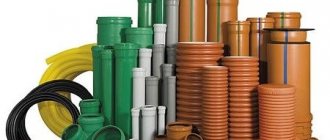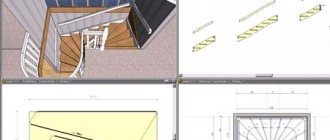26.01.2021
Septic tank
Editorial staff of the “New Place” website
Share
From this article you will learn
:
- The principle of operation of a septic tank
- Location and volume of the septic tank
- 5 factors influencing the depth of a septic tank
- Depth of sewer pipes for septic tank
- The depth of the septic tank itself on the territory of a private house
- Installation depth of a septic tank made of concrete rings
The question of what the depth of the septic tank and the sewer pipes suitable for it should be should in no case be ignored. If certain points are not taken into account in the calculations, this will certainly affect the functionality of the entire system, and, as you might guess, not in the best way.
Unfortunately, there is no clear answer to the question of how thoroughly to bury a septic tank in the ground. Too much depends on factors such as the terrain, groundwater level, and the depth of soil freezing. Although some general rules can still be highlighted here.
The principle of operation of a septic tank
To make an autonomous sewer system in a country house, you can purchase a factory-made septic tank and install it yourself. It is made of fiberglass, polyethylene, and metal containers are also available. Such tanks are completely sealed and have a neck and hatch. A septic tank is the optimal solution when the groundwater level in the area where the cottage is located is quite high.
Wastewater consists of organic matter, which goes through a mineralization process during waste settling. This happens in two stages: first, wastewater flows through sewer pipes into a reservoir, where it is clarified. After initial treatment, wastewater is absorbed into the soil or sent for further treatment to special filtration facilities.
The septic tank is made in the form of a round or rectangular well. It consists of 1–3 tanks separated from each other, the bottom and walls of which do not allow water to pass through. Above the septic tank there are floor slabs with openings for hatches, through which you can inspect and repair equipment. From the outside, the surface is protected with waterproofing material - roll or coating type. The grooves of the pit are covered with 50 cm of soil, and there is also a slope to prevent natural precipitation from accumulating.
The functioning of a septic tank is as follows: sewage slowly passes through the tanks. As a result, organic particles settle down and the water becomes clarified. Then, over time, the sediment disintegrates under the influence of anaerobic bacteria.
Solid organic matter partially transforms into a gaseous state and evaporates. The remaining part is mineralized.
Location and volume of the septic tank
How to correctly determine the depth of the septic tank, as well as choose its location:
- The reservoir should be located lower than the cottage, in the direction of the landscape slope of your territory.
- The minimum distance to the house is 5–8 meters. If the length of the pipes is more than 10 meters, you should make a well through which you can remove the blockage and clean the sewer if necessary.
- If you plan to install a septic tank along with a filter tank, you will need a space of at least 36 cubic meters (assuming the flow rate is 1 cubic meter per day). The distance of the site to the road is from 5 meters, to a natural reservoir – 10–30 meters, to garden plantings – 3 meters, to a source of drinking water – 50 meters.
- Sewer pipes should be laid in a straight line, without making sharp turns or right angles. According to the rules, you can make two bends of 45 degrees each.
- To prevent the pungent smell from the sewage system from bothering you and your neighbors, you should equip it with ventilation, as well as a system for soil post-treatment of wastewater.
- It is important to position the septic tank so that vacuum cleaners can drive to it using special equipment and clean the tank. The access road should be at such a distance that the hoses of the sewer truck (15–35 m long) reach the tank.
The volume of the septic tank is calculated taking into account the maximum daily water consumption. The calculated volume of the tank includes the area required for wastewater, including the thickness of the sediment layer.
To correctly determine the required size of the septic tank, the recommended coefficients should be taken into account. When on average you use no more than 5 cubic meters of water per day, you should take the current consumption value and multiply it by 2.5.
For example, you consume 750 liters of water per day, to determine the volume of the tank, you should multiply 750 by 2.5, we get 1875 liters.
This is interesting!
Size of a septic tank for a summer residence: how to determine and choose the right one Read more
If the volume of liquid consumed is more than 5 cubic meters, it should be multiplied by a factor of 3.
Depth of sewer pipes for septic tank
When installing an autonomous sewer system, it is important to take into account design standards so that the depth of the septic tank in a private house is optimal. However, the sewerage system also includes a pipeline, the location of which is determined in SNiP 2.04.03–85.
Many homeowners are confident that if the depth of the septic tank and pipeline is maximized, the sewage system will work better. But this opinion is wrong, and here's why:
- First of all, the costs of creating a sewer system will increase, while the unnecessary costs incurred will simply be inappropriate.
- In addition, if the pipeline is placed at maximum depth, fatigue cracks may develop in the manifold. This happens because the soil pressure on the pipes increases too much due to heaving during freezing or erosion during seasonal floods.
- Maintaining a sewer system at great depth is quite difficult.
What should be the depth of the entrance to the septic tank for the system to function properly? To avoid mistakes, you should create the required slope from the cottage to the tank. When setting up a VOC, it is important to take into account the climate of the region in which you live, the features of the landscape, and the specifics of the soil.
If the site is located in a region with a temperate climate, sewer pipes can be laid at a depth of 0.3-0.4 meters. If the pipe diameter is more than 50 cm, you should add another 10 cm. If you live in the North, you need to increase the depth by 25–30%.
Important!
Remember about the slope so that waste water flows into the septic tank. In the case where, at the entrance to the cottage, the outlet for the pipeline is located at a distance of 0.7 m, the depth of entry of the pipe into the tank, which is located at a distance of 7 m, should be 0.8 m.
To determine the depth of pipes, many formulas are used. We recommend using the following:
Hin = Hout + L * k + G
How it stands for:
- Hin – depth from the surface to the entrance to the septic tank;
- Hout – the depth at which the area where the pipe exits the cottage is located, the standard parameter is 140 cm;
- L – distance to the cottage;
- k is a special coefficient that takes into account the diameter of the pipeline;
- G – natural slope of the pipeline, standard value 30 cm.
The minimum depth of the septic tank is determined taking into account the distance from the surface at which the pipeline is laid, as well as the supply pipe. For it, a slope of at least 2 cm is important. Knowing all the above values, the necessary parameters for placing the equipment on the site are calculated.
Sewage scheme
The sewerage system in a private house consists of an internal part and an external part. They have different components and are often made from different materials. In houses and on plots, such systems are installed in a non-pressure way, i.e. The wastewater flows through the system by gravity. Therefore, despite its apparent simplicity, the sewerage system needs to be designed much more than a pressure water supply network. Currently, domestic sewage is collected exclusively from plastic socket pipes.
Internal
The internal sewerage system consists of horizontal sewer pipes and vertical risers (drain pipes) connected to plumbing fixtures (sinks, sinks, bathtubs, toilets) and equipment (washing machines and dishwashers).
The internal sewer network must also have a ventilation pipe leading outside the roof; inspection of risers to clear blockages. For risers and toilet flushes, pipes with an outer diameter of 110 millimeters are used, for connecting a bathtub - 50 millimeters, for washbasins, sinks, washing machines and dishwashers - 40 millimeters.
External
The external sewer line has a more complex design than the internal one. The depth of laying communications, the volume and depth of septic tanks is calculated based on the volume of wastewater, the characteristics of the geological structure of the site, the climatic features of the region, the layout of the site (if there is an entrance to the house or a parking lot above the communications).
If it is not possible to connect the external network to the municipal sewer collector (the distance from the collector to the house is too great), then a wastewater collection site will have to be equipped on the site (cesspool, septic tank, storage tank or treatment facility). For drainage, a pipe with a diameter of 110 mm is needed; reinsurers can use products with a diameter of 150 mm.
The depth of the septic tank itself on the territory of a private house
Now you know at what depth to place the sewer pipes. But how do you understand how deep the septic tank itself should be in a country cottage?
To answer this question, you should adhere to sanitary standards and rules. The document containing these standards states that this parameter is at least 200 cm. However, the given value is averaged, it can be more or less, it all depends on the characteristics of the trench for the sewer system, as well as on the specifics of the soil.
The principle to adhere to is the following: the septic tank should be located lower than the collector. It is important to take into account the slope for each meter, no matter what the level of soil freezing.
Thus, according to SNiP standards, at the exit from the cottage the pipeline must be located 0.3 m higher than the soil freezing level. The trenches should be located at a distance of 0.5–0.7 m from the surface. If the length of the sewer system is 7 m, then the total depth of the inlet pipe will be 0.8 m. The height of the tank must be added to this value. This way you can determine the size and depth of the pit for the septic tank.
Don't forget about the drain pipe. It must be arranged so that there is a slope at the entrance to the septic tank of at least 2 cm. This is necessary so that wastewater flows freely into the filter.
This is interesting!
The septic tank has silted up: what to do and how to avoid further problems Read more
Given the fact that the ambient temperature will be low for a long period of time, it is important to prevent the soil from thawing where the tank is located.
The septic tank should be placed so that it protrudes no more than 0.1 m above the ground surface. Otherwise, additional fasteners will need to be installed.
Recommendation from professionals! Before installing a septic tank, it must be filled with water. This will prevent the appearance of cracks on the surface. The equipment will last a long time and will not fail.
How to choose a location for a wastewater receiver and calculate its parameters
The location for the wastewater receiver is determined based on the following regulatory data:
- The distance from the foundation of the house to the wall of the cesspool must be at least 15 m.
- Septic tanks - up to 5 m.
- Drainage and overflow wells - at least 15 m.
- Biological treatment stations and autonomous treatment facilities - up to 3 m from the building foundation.
- The distance to a busy road is at least 5 m.
Placing containers close to the house reduces the number of trenches in a private area, but may cause an unpleasant odor near the house.
There is a recommendation - to place cesspools and drainage wells in the lowest place on the site. For modern cleaning systems this is no longer so relevant. But it is important to place containers and equipment in a place accessible to the access of a vacuum barrel for the evacuation of settling residues in septic tanks. Otherwise, in the event of force majeure situations, the car may not arrive, or green spaces may be damaged.
Experts recommend calculating the capacity of the wastewater receiver based on the composition of the family and the standard water consumption per person - 11.68 m² per month. These consumption standards are accepted by public utilities. As practice shows, people usually do not exceed this consumption rate.
Multiplying the number of family members by 11.68 m², we obtain the monthly volume of wastewater. It is advisable to increase this volume by 10-20% - in case of guests arriving, a total wash, or a delay in the arrival of the sewage disposal truck. The volume of the septic tank is calculated depending on the ability to often call a machine to pump out the contents - this can be once a month, once every two weeks or less.
Installation depth of a septic tank made of concrete rings
It is important to know the permissible depth of septic tanks for sewerage even if you plan to construct the structure yourself using concrete rings. Even a beginner can handle this work, but it is important to choose the right distance from the tank to the surface of the earth.
In order not to make a mistake with the depth of a septic tank made of concrete rings, in addition to everything described above, namely the groundwater level, the level of soil freezing, the characteristics of the territory, it is important to determine the number of rings that will make up the structure.
How many concrete rings will be used depends on the volume of the tank. The more actively you use the sewer, the larger it will be. Rings are produced with a height of 0.9 m. Before constructing a pit, you should calculate the required number of rings for the tank, taking into account the depth of soil freezing, as well as the groundwater level.
Note! The cut of the lower ring is not placed on the ground, but on a cushion of sand or gravel, the height of which is 0.2-0.3 m.
It is worth noting that such septic tanks, as well as cesspools, are used less and less. Most homeowners prefer to install a factory-made septic tank for a summer house or cottage at the required depth. In this case, there is no need to often call sewer trucks to pump out sediment from the tank. The initial costs of arranging such a sewer system quickly pay off with its further use.
It is important to correctly calculate the volume, as well as determine the design features. a septic tank so that you don’t have to constantly call a sewer truck. When sewerage works effectively, the treated liquid that seeps into the soil is completely safe and does not harm drinking water sources. Another advantage of installing modern septic tanks is that there will be no unpleasant odor at your dacha that comes from a cesspool.
;
Septic tank
Did you find this article helpful? Share it with your friends:
Pipeline insulation
An example of external network insulation
Insulating a sewer pipe helps prevent the formation of condensation and ice on the inner walls of the channel. There are many options for installing a heat insulator, but the most effective and reliable is the use of molded insulation (shell). Other types of thermal insulation materials can be used:
- foamed polyethylene;
- liquid polyurethane foam;
- polystyrene foam or polystyrene foam.
The main requirement for the material is complete impermeability and physical resistance to moisture. It would be a mistake to use mineral wool, loose or loose types of insulation, since they will not be able to form an airtight seal for the water that has filled the trench or tray.
It must be remembered that the greater the depth of the sewer pipes, the closer the groundwater will be located. During a seasonal increase in their level, the pipe may be immersed in water, and if frost suddenly strikes, the system will inevitably freeze. Therefore, in parallel with the installation of a heat insulator, attention should also be paid to the waterproofing of the system.
You may also like: Heating cable for sewer pipes: types, advantages, installation











